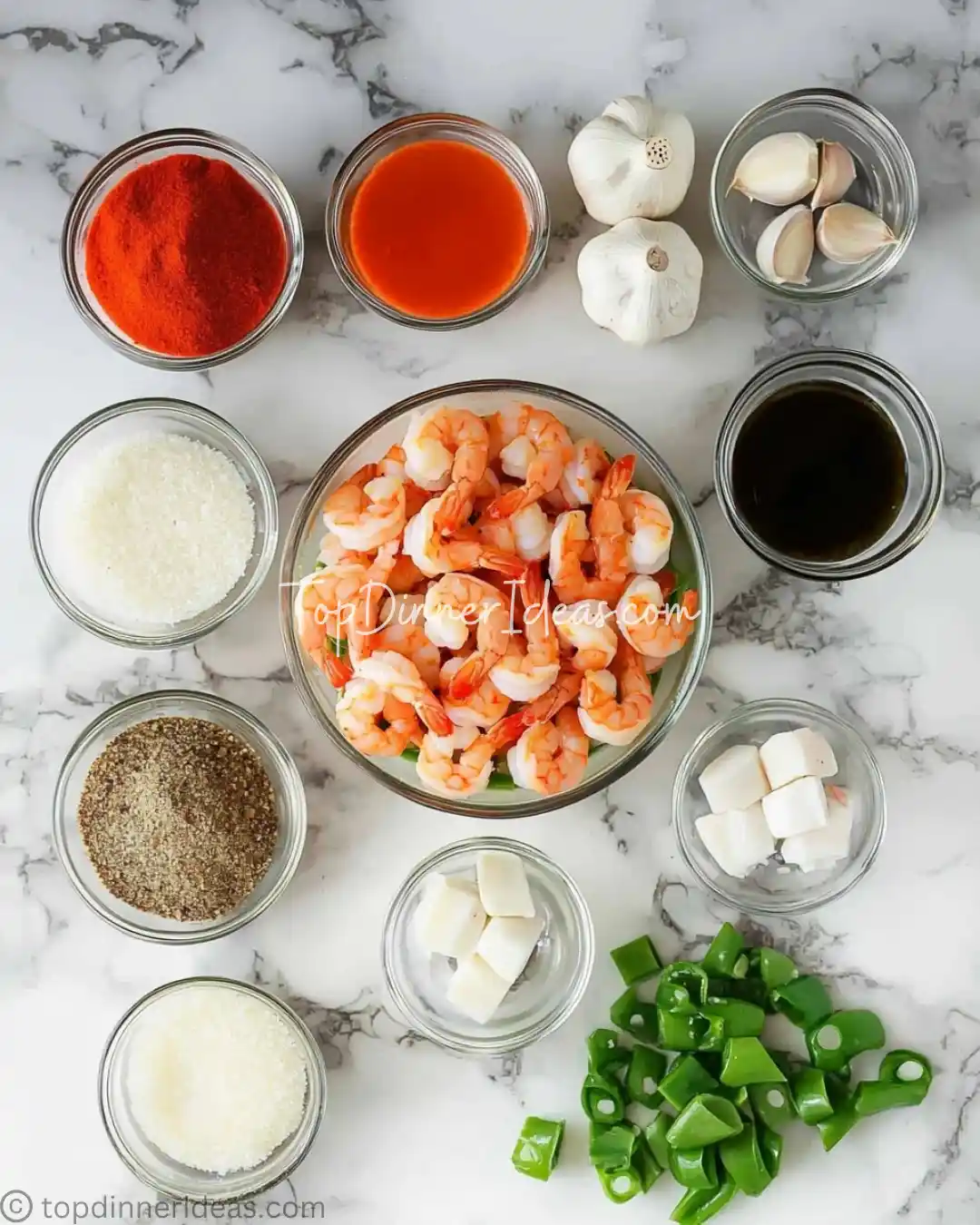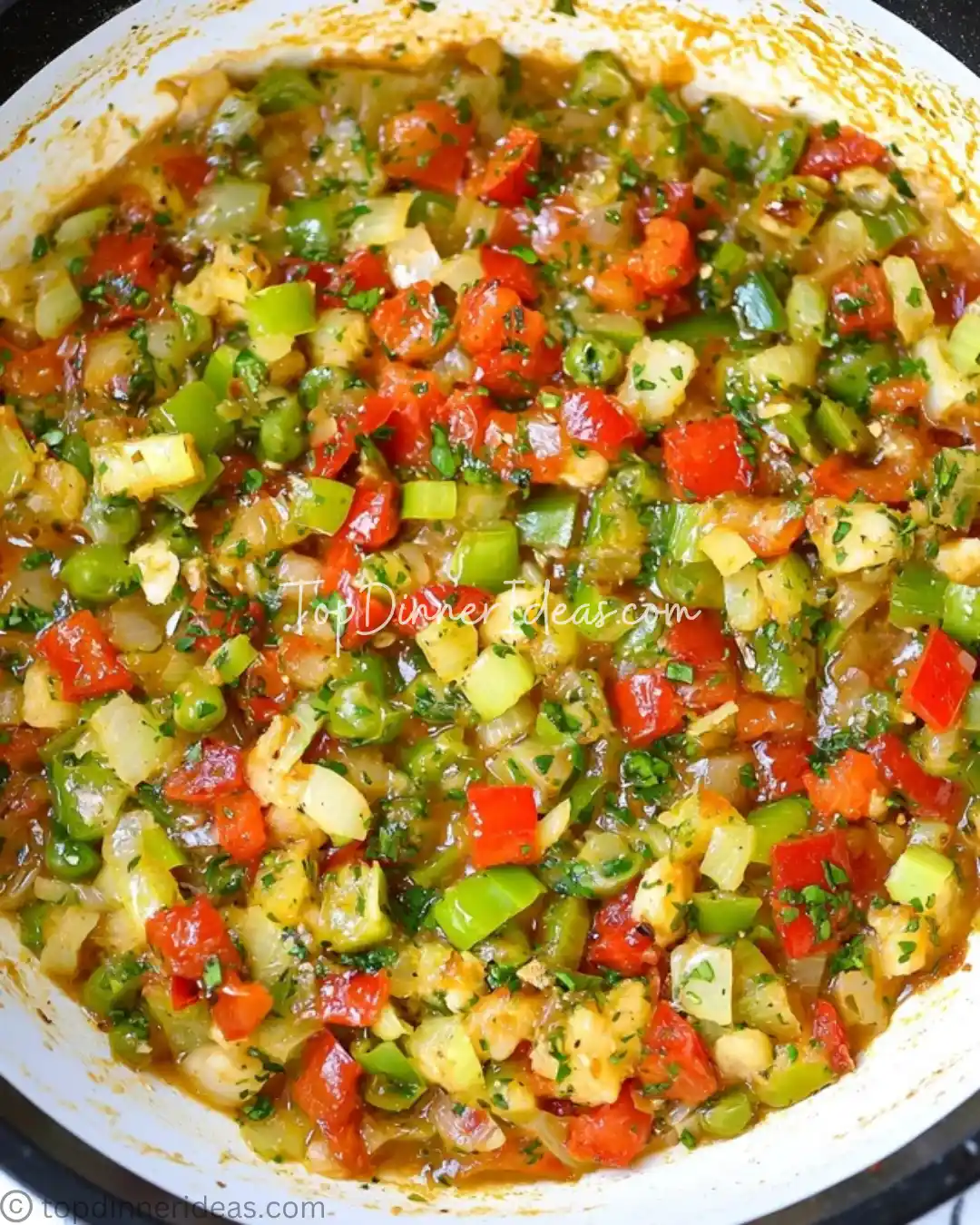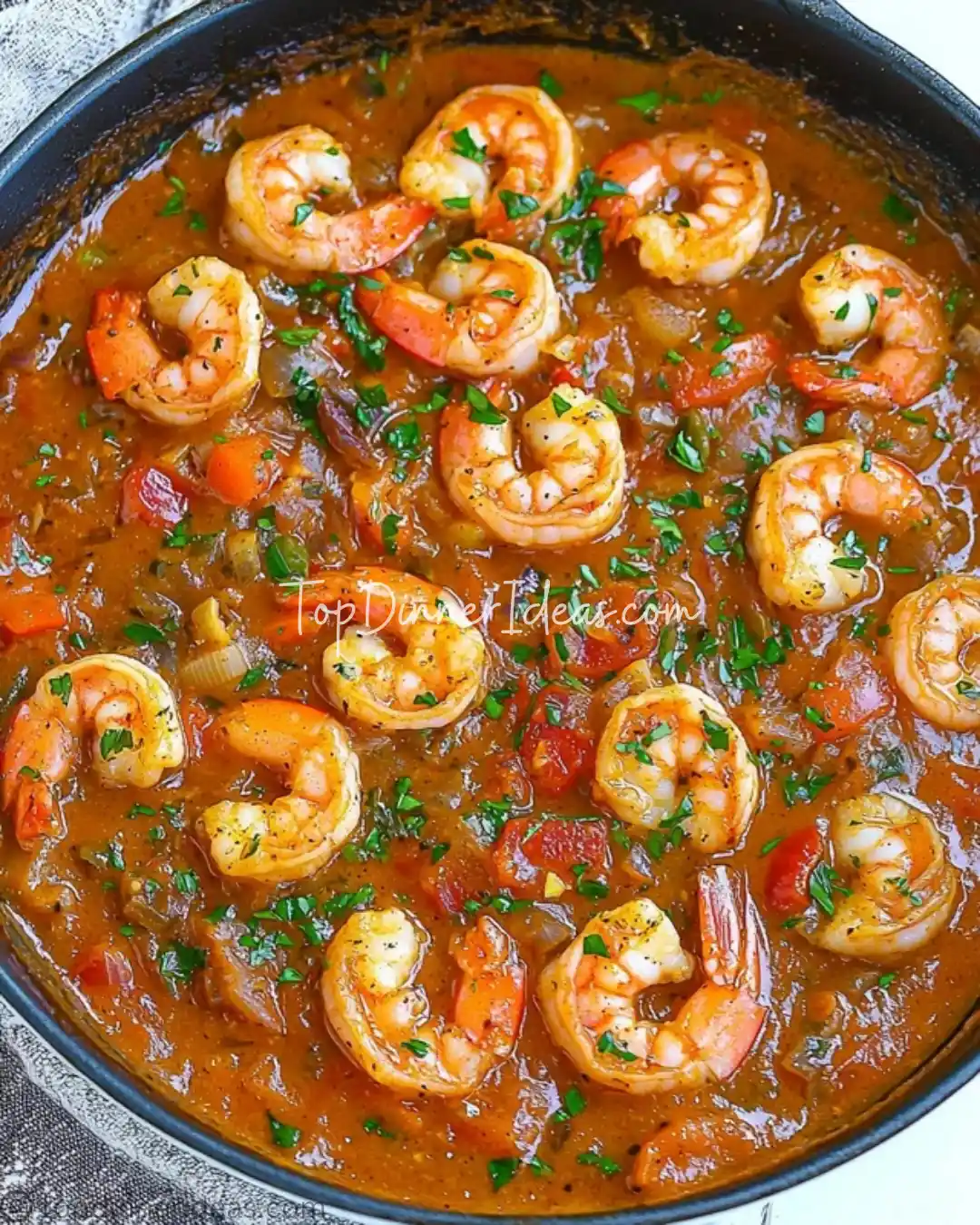The technique hinges on making a dark roux equal parts flour and oil cooked until nutty brown then layering in vegetables, spices, stock, and tomatoes before simmering the shrimp just until tender. With each step roux, aromatics, stock, seasoning, shrimp you’ll learn how to master a seafood étouffée that’s rich, spicy, and deeply satisfying.

For best results, use fresh or thawed shrimp, homemade or quality store-bought stock, and fresh vegetables; the careful development of each flavor layer is what makes this shrimp etouffee recipe sing. Serve this classic shrimp étouffée over fluffy white rice, garnish with green onions and parsley, and let the bold Louisiana flavors transport you to the bayou.
Equipments for Shrimp Étouffée
The right equipment ensures smooth execution and even cooking when making shrimp étouffée.
- Heavy-Bottomed Dutch Oven or Large Pot: For making roux, simmering sauce, and cooking shrimp.
- Wooden Spoon or Sturdy Whisk: To stir and scrape the roux without burning.
- Cutting Board & Sharp Knife: For chopping the Holy Trinity and other ingredients.
- Measuring Cups & Spoons: For precise spice and liquid measurements.
- Ladle: For serving sauce over rice.
- Heat-Resistant Spatula: To monitor roux color and prevent sticking.
Having these tools at the ready sets you up for a flawless shrimp étouffée from roux to simmer.
Ingredients for Shrimp Étouffée
Select fresh, high-quality ingredients for the most authentic, flavorful shrimp étouffée.
Roux & Base:
½ cup vegetable oil (or butter/oil blend)
½ cup all-purpose flour

Holy Trinity & Aromatics:
1 large onion, diced
1 green bell pepper, diced
2 celery stalks, diced
4 garlic cloves, minced
Liquids & Seasonings:
3 cups seafood stock (shrimp or crab stock preferred)
1 cup canned diced tomatoes (drained)
2 tsp Cajun or Creole seasoning
1 tsp smoked paprika
½ tsp dried thyme
½ tsp dried oregano
¼ tsp cayenne pepper (adjust to heat preference)
Salt and freshly ground black pepper, to taste
Seafood & Finish:
1½ lbs large shrimp, peeled and deveined
2 tbsp unsalted butter
2 green onions, sliced
2 tbsp fresh parsley, chopped
1 tbsp Worcestershire sauce (optional)
Cooked white rice, for serving
With these ingredients assembled, you’ll layer flavor from the roux to the shrimp for a truly classic shrimp étouffée.
Instructions to Shrimp Étouffée Recipe
Follow these detailed steps to craft a rich, authentic shrimp étouffée that’s sure to become a family favorite.
Make the Roux (15–20 minutes):
– In a Dutch oven over medium heat, combine oil and flour.
– Stir constantly with a wooden spoon or whisk, scraping the bottom, until the roux turns a deep peanut-butter brown (not too dark) and smells nutty—about 15–20 minutes.

Sauté the Holy Trinity (5 minutes):
– Add diced onion, bell pepper, and celery to the roux; stir to coat.
– Cook until vegetables are translucent, ~5 minutes.
– Stir in garlic and cook 1 minute more.

Build the Étouffée Base (5 minutes):
– Gradually whisk in seafood stock, scraping up any browned bits.
– Add diced tomatoes, Cajun seasoning, paprika, thyme, oregano, cayenne, Worcestershire (if using); bring to a simmer.

Simmer & Thicken (10 minutes):
– Reduce heat to low; cover partially and simmer gently 10 minutes to meld flavors and thicken slightly.
– Season with salt and pepper to taste.

Add Shrimp & Finish (5 minutes):
Stir in shrimp and butter; simmer until shrimp turn pink and opaque, about 5 minutes do not overcook.
Serve:
– Spoon hot rice into bowls; ladle shrimp étouffée over rice.
– Garnish with sliced green onions and chopped parsley. Serve immediately.
By following these steps careful roux, sautéed vegetables, seasoned stock, and tender shrimp you’ll achieve a shrimp étouffée recipe that’s rich, spicy, and authentically Cajun.
Allergen Information for Seafood étouffée
Please note these allergen details to accommodate all guests.
- Shellfish: Contains shrimp and seafood stock; unsuitable for shellfish allergies.
- Gluten: Includes flour in roux; use gluten-free flour blend if needed.
- Dairy: Butter optional; omit or substitute with dairy-free margarine for a dairy-free version.
By noting these allergens, you can substitute ingredients ensuring everyone can enjoy this seafood étouffée.
Substitutions for Seafood étouffée
Customize the recipe with these substitutions based on dietary preferences and availability.
- Stock: Use chicken broth + a splash of fish sauce if seafood stock unavailable.
- Roux Fat: Substitute oil with equal butter or bacon fat for smoky depth.
- Spices: Swap Creole seasoning for homemade blend of paprika, garlic powder, onions powder, cayenne, and thyme.
- Seafood: Add crab meat, crawfish tails, or scallops for variation.
- Rice: Serve over cauliflower rice for low-carb.
These swaps let you adapt shrimp étouffée from scratch to your pantry while preserving its classic flavor layers.
Variations of Shrimp Étouffée
Keep your étouffée exciting with these creative variations.
- Crawfish Étouffée: Replace shrimp with 1 lb crawfish tails.
- Chicken & Sausage Étouffée: Use diced chicken and Andouille sausage for a creole twist.
- Vegetarian Étouffée: Omit seafood; use mushrooms and vegetable stock.
- Spicy Kick: Increase cayenne and add chopped jalapeños.
- Creamy Étouffée: Stir in ½ cup heavy cream at the end for richness.
- Herb-Bright: Finish with fresh basil and thyme instead of parsley.
These variations ensure your shrimp étouffée remains versatile, from seafood medleys to vegetarian renditions.
Notes on shrimp etouffee from scratch
Keep these tips in mind to perfect your shrimp étouffée.
- Patience with Roux: Stir constantly to avoid burning; the darker the roux, the more flavor.
- Even Veg Chops: Uniform sizes ensure consistent cooking.
- Simmer Gently: A low simmer prevents roux-break separation and tough shrimp.
- Taste & Adjust: Season in stages after stock, after simmer, after shrimp to layer flavors.
- Make Ahead: Roux and base can be prepared one day ahead; store covered in fridge.
- Rest Before Serving: Let étouffée sit off heat 5 minutes to thicken further.
These notes help you avoid overcooked shrimp, broken roux, or under-seasoned sauce ensuring a perfect étouffée.

Health Benefits of Shrimp Étouffée Recipe
Shrimp étouffée delivers both flavor and nutrition in every hearty bowl.
- Shrimp: High in lean protein, vitamin B12, and selenium.
- Vegetables: Onion, celery, and bell pepper provide fiber, vitamins, and antioxidants.
- Olive Oil/Bacon Fat: Healthy monounsaturated fats (use olive oil for heart health).
- Spices: Paprika and cayenne offer anti-inflammatory compounds.
- Herbs: Parsley adds vitamin K and fresh flavor without sodium.
With lean shrimp, nutrient-rich vegetables, and thoughtful fat choices, this étouffée balances indulgence and nourishment.
Nutrition Information
Here’s an approximate nutritional breakdown per serving for this shrimp étouffée over rice.
- Calories: 420 kcal
- Protein: 28 g
- Carbohydrates: 30 g (including rice)
- Fat: 18 g (saturated fat 4 g)
- Fiber: 3 g
- Vitamins & Minerals: Rich in vitamin C, B12, selenium, and potassium
These values help you enjoy shrimp étouffée within a balanced meal plan, savoring its bold flavors mindfully.
Nutritional values can vary based on specific ingredient brands and measurements used. For more precise information, refer to the labels of your chosen ingredients.
Cooking Tips for Seafood étouffée
Use these expert tips to ensure your shrimp étouffée is authentic and delicious.
- Monitor Roux Color: Aim for peanut-butter brown; too dark can taste burnt.
- Don’t Rush Simmer: Thickening and flavor melding require time off a rolling boil.
- Prep Shrimp Last: Add shrimp at the very end to avoid rubbery texture.
- Layer Seasonings: Season after each major ingredient addition for depth.
- Deglaze Well: Use stock or wine to scrape up fond for extra flavor.
- Use Fresh Shrimp: Thaw thoroughly and pat dry to prevent excess water in sauce.
Applying these tips guarantees a shrimp étouffée with deep roux flavor, tender shrimp, and a perfectly balanced sauce.
Storage Advice for Seafood étouffée
Store and reheat your étouffée properly to preserve its quality.
- Refrigeration: Cool to room temperature; store in airtight container for up to 2 days.
- Reheating: Warm gently over low heat, stirring to reincorporate any separated roux.
- Freezing: Not recommended (roux and shrimp texture suffer); instead freeze base sauce pre-shrimp.
- Labeling: Date containers to track freshness.
Proper storage and gentle reheating help retain the étouffée’s creamy texture and vibrant flavor.

Serving Suggestions for Shrimp Étouffée
Complement shrimp étouffée with these classic and creative sides.
- White Rice: Jasmine or long-grain rice soaks up the sauce.
- French Bread or Baguette: For sopping up every drop.
- Cornbread: Adds slight sweetness and texture contrast.
- Simple Green Salad: A light vinaigrette balances richness.
- Grilled Asparagus: Briny vegetable side complements Cajun spices.
- Cajun-Style Wings: For a surf-and-turf spread at gatherings.
Choose one or more of these sides to round out your shrimp étouffée dinner with complementary textures and flavors.
Troubleshooting Shrimp Étouffée
Solve common étouffée issues with these quick fixes.
- Burnt Roux: Lower heat and stir continuously; if burnt, start roux over.
- Thin Sauce: Simmer uncovered to reduce or whisk in extra roux slurry.
- Thick or Lumpy Sauce: Strain and gently whisk in additional stock.
- Rubbery Shrimp: Add shrimp only at end and cook just until opaque.
- Under-seasoned: Taste mid-simmer and adjust Cajun seasoning, salt, or cayenne.
These solutions help you correct texture and seasoning on the fly, ensuring perfect shrimp étouffée every time.
FAQ About Shrimp Étouffée
Large, peeled, deveined shrimp (16–20 count) for tender bites.
Yes; thaw, pat dry, and add at the end to avoid excess water.
It’s mildly spicy; adjust cayenne and Cajun seasoning to taste.
Prepare sauce ahead; add shrimp just before serving for best texture.
A Cajun base of onion, bell pepper, and celery.
Stir constantly and maintain medium heat.
Yes; classic New Orleans étouffée is tomato-free.
Long-grain white or jasmine rice for light, fluffy grains.
Use gluten-free flour in the roux.
Freeze base sauce pre-shrimp; add fresh shrimp when reheating.
With these FAQs answered, you’ll confidently prepare shrimp étouffée that showcases classic Cajun flavors with every spoonful.
Footnotes for Shrimp Étouffée
Shrimp étouffée is a cornerstone of Cajun cuisine, marrying the deep, nutty flavor of a well-cooked roux with the vibrant trinity of onions, bell peppers, and celery.
The roux provides body and color, while the Holy Trinity and garlic build aromatic complexity. Slow addition of stock and spices Cajun seasoning, paprika, thyme, and cayenne allows each layer of flavor to deepen. Adding shrimp at the very end ensures delicate seafood remains tender and succulent.
Serving over rice absorbs the rich sauce, making each bite a harmony of spice, buttery roux, and plump shellfish. For variations, swap shrimp for crawfish, incorporate smoky sausage, or finish with cream for a luxurious touch.
Whether you follow a Southern Living shrimp étouffée recipe or craft yours from scratch using this guide, mastering the roux and timing is key to an authentic, mouthwatering étouffée experience that honors Louisiana’s culinary heritage.
For more inventive recipes and culinary inspiration, Navigate to our Main Dishes section, or visit Trustedrecipe, Spendwithpennies or explore additional ideas on Allrecipes. Thank you for choosing this recipe may every spoonful bring comfort, joy, and a taste of home to your table!



